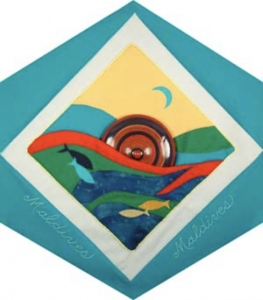Maldives

The Block
Joan M. McGrath re-created the tropical waters, which make up the island nation of Maldives, using an assortment of colourfully layered cottons. An example of klaajehun (lacquer work), a centuries-old craft that is still carried on as a family tradition, is gently tucked inside the pocket of rolling waves. Historically large containers coated with lacquer were used to serve food at various community gatherings while smaller items, such as wooden pots, boxes and vases were, and still are, used for household purposes. Although many different colours are now used to create designs, this example features an abstract pattern in traditional colours of red, black, yellow and green. A crescent moon hangs over the warm waters through which several tunas swim. Maldives’ economy relies to a large extent on the fishing industry and the country is famous for its Maldive Fish, which is produced by boiling, smoking, curing and drying tuna.
Cultural Profile
Maldives, an island republic in southern Asia, is located in the northern Indian Ocean off the southwest coast of India. One of the world’s tiniest countries (only 298 km2), it is made up of a chain of nearly 1,200 small, low-lying coral islands that are grouped into 26 atolls. None of the 200 which are inhabited rise more than 1.8 metres (6 ft) above sea level. Like other people living on coral atoll nations, Maldivians worry about the potentially serious consequences of global warming to their homeland. The country was once a British protectorate, which in an unusual arrangement, retained internal self-government. It became completely independent in 1965. Maldives’ population is of Dravidian, Sinhalese, Arab and African origin and the official language is Divehi, an Indo-European tongue related to Sri Lanka’s Sinhalese.
Maldivians are friendly, hospitable and peace-loving. As a result of the country’s location along the ancient marine trade routes from the West to the East, their culture has been influenced by early explorers who inevitably stopped at the islands on their journeys. For example, the bodu beru traditional drum dance shows clear signs of Eastern African influences, while the Devihi language comprises borrowed words from Persian, Arabic or Portuguese. Islam, the faith of most Maldivians, was introduced by Arab visitors.
Dress and adornments were historically an important part of Maldivian society and ornaments and textiles once formed an integral part of the country’s exports. Western clothing is gradually being introduced to the islands, but traditional dress, such as the libaas (woman’s long-sleeved dress embroidered at the wrists and around the neck) and the mundu (man’s cloth wrapped around the waist) are still worn ceremonially and on special occasions.
Maldivians are known for a variety of handcrafts, including finely woven feyli (sarongs), turtle shell and coral jewelry, mats woven from hibiscus bark fibers and hau grass, and coir (fibre from coconut husks) products. The coconut tree, a readily available resource on the islands, is used in many ways: timber, fruits and fronds are used for building, cuisine and crafts. The traditional dhonis (boats), for example, are used as the main mode of transportation between the islands. These were traditionally made of coconut timber. The tradition of boat building is still being passed on from master craftsmen to apprentices.
People have been coming to Canada from Maldives since 1988. The Census records indicate however that there are only a few Maldivians currently living here.
Sponsor: Margaret Richards
